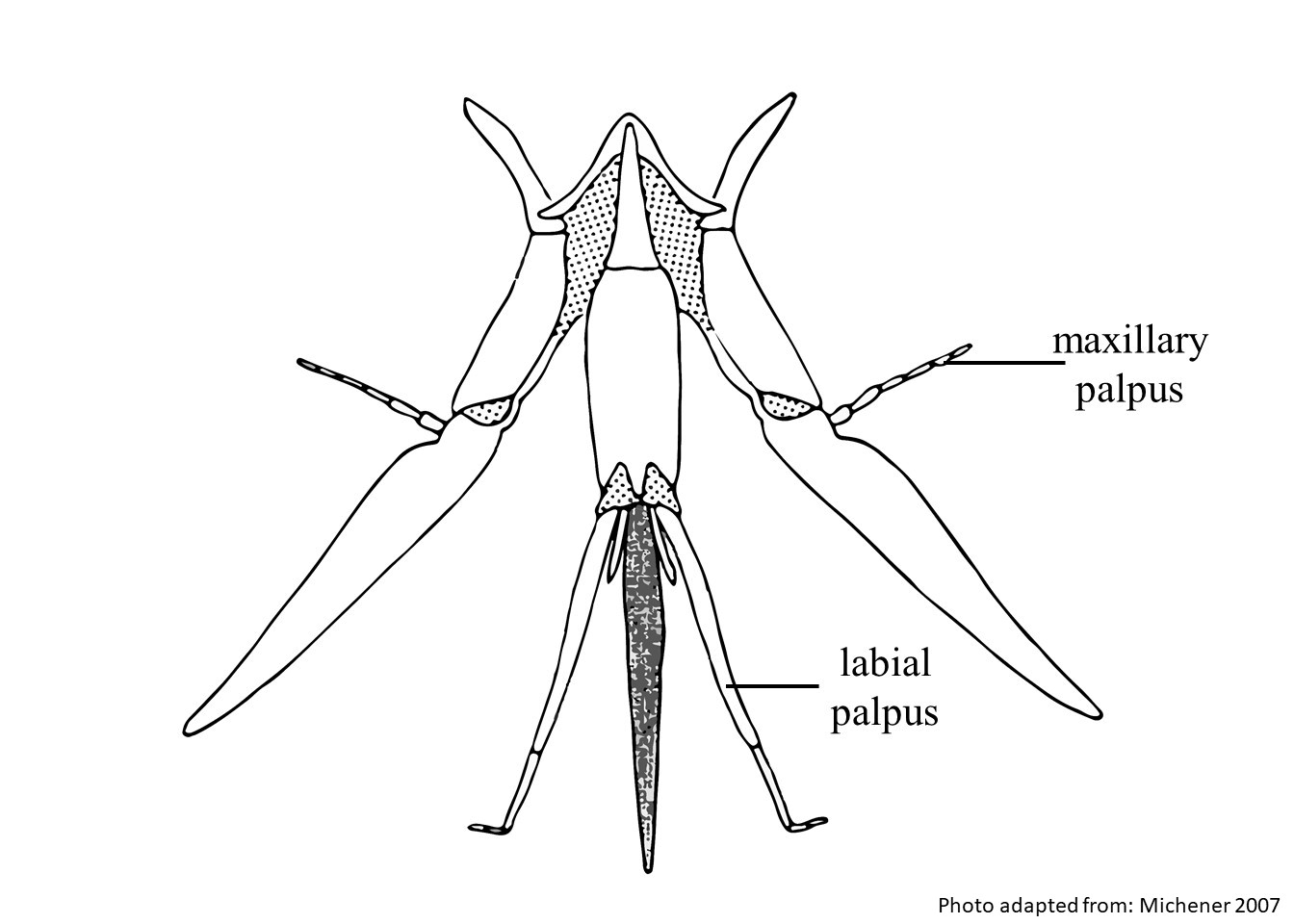Family: Megachilidae
Subfamily: Megachilinae
Tribe: Osmiini
Genus: Haetosmia Popov, 1952
Subgenera: none
Common name: none
Haetosmia are robust, black bees with dense white or pale hairs covering much of their bodies, and a spherical thorax. They range in body length from 5–7 mm (Michener 2007Michener 2007:
Michener, C.D. 2007. The Bees of the World (2nd ed.). Johns Hopkins University Press, Baltimore and London, 953 pp.).
Haetosmia contains 6 species worldwide (Müller and Griswold 2017); none are known to occur in the U.S. or Canada (Michener 2007Michener 2007:
Michener, C.D. 2007. The Bees of the World (2nd ed.). Johns Hopkins University Press, Baltimore and London, 953 pp.).
(modified from Michener 2007Michener 2007:
Michener, C.D. 2007. The Bees of the World (2nd ed.). Johns Hopkins University Press, Baltimore and London, 953 pp.)
 twice as long as broad or more.
twice as long as broad or more. .
. enlarged, covering most of S3S3:
enlarged, covering most of S3S3: .
. without basalbasal:
without basalbasal: with laterallateral:
with laterallateral: broadly truncatetruncate:
broadly truncatetruncate:Haetosmia may be confused with Hoplitis due to their superficially similar appearance; however, females do not have modified bristles on the labial palpslabial palps:
one of the pair of jointed, sensory structures carried on the labium of the mouth parts
 or dorsally bulging T7T7:
or dorsally bulging T7T7:
the segments on the top side of the abdomen, often abbreviated when referring to a specific segment to T1, T2, T3, T4, T5, T6, or T7 in males (Michener 2007Michener 2007:
in males (Michener 2007Michener 2007:
Michener, C.D. 2007. The Bees of the World (2nd ed.). Johns Hopkins University Press, Baltimore and London, 953 pp.).
There are no known invasives.
All three species of Haetosmia are most likely specialized on Heliotropium (Boraginaceae) (Gotlieb et al. 2014Gotlieb et al. 2014:
Gotlieb, A., G. Pisanty, J.G. Rozen Jr., A. Muuml;ller, G. Rouml;der, C. Sedivy, and C. Praz. 2014. Nests, floral preferences, and immatures of the bee Haetosmia vechti (Hymenoptera: Megachilidae: Osmiini). American Museum Novitates 3803: 1ndash;20.). The second segment of the labial palp possesses modified spoon-shaped bristles that assist females in extracting pollen from the narrow flowers (Gotlieb et al. 2014Gotlieb et al. 2014:
Gotlieb, A., G. Pisanty, J.G. Rozen Jr., A. Muuml;ller, G. Rouml;der, C. Sedivy, and C. Praz. 2014. Nests, floral preferences, and immatures of the bee Haetosmia vechti (Hymenoptera: Megachilidae: Osmiini). American Museum Novitates 3803: 1ndash;20.).
The overall nesting habits of Haetosmia are not well known. Haetosmia vechti, H. circumventa, and H. brachyura nest underground by excavating burrows into sandy soil (Gotlieb et al. 2014Gotlieb et al. 2014:
Gotlieb, A., G. Pisanty, J.G. Rozen Jr., A. Muuml;ller, G. Rouml;der, C. Sedivy, and C. Praz. 2014. Nests, floral preferences, and immatures of the bee Haetosmia vechti (Hymenoptera: Megachilidae: Osmiini). American Museum Novitates 3803: 1ndash;20.; Müller 2018b). Urn-shaped cells are built in clusters or a linear series out of masticated leaf pulp mixed with small pebbles and sand grains (Gotlieb et al. 2014Gotlieb et al. 2014:
Gotlieb, A., G. Pisanty, J.G. Rozen Jr., A. Muuml;ller, G. Rouml;der, C. Sedivy, and C. Praz. 2014. Nests, floral preferences, and immatures of the bee Haetosmia vechti (Hymenoptera: Megachilidae: Osmiini). American Museum Novitates 3803: 1ndash;20.).
Haetosmia can be found in the Canary Islands, southern Morocco, Kenya, Egypt, Israel, Iran, western Pakistan, and central Asia (including Uzbekistan) (Michener 2007Michener 2007:
Michener, C.D. 2007. The Bees of the World (2nd ed.). Johns Hopkins University Press, Baltimore and London, 953 pp.).
Distribution map generated by Discover Life -- click on map for details, credits, and terms of use.
Gotlieb, A., G. Pisanty, J.G. Rozen Jr., A. Müller, G. Röder, C. Sedivy, and C. Praz. 2014. Nests, floral preferences, and immatures of the bee Haetosmia vechti (Hymenoptera: Megachilidae: Osmiini). American Museum Novitates 3803:1-20.
Michener, C.D. 2007. The Bees of the World (2nd ed.). Johns Hopkins University Press, Baltimore and London, 953 pp.
Müller, A. 2016. Palaearctic Osmiine Bees. ETH Zürich, http://blogs.ethz.ch/osmiini.
Müller, A. and T.L. Griswold. 2017. Osmiine bees of the genus Haetosmia (Megachilidae, Osmiini): biology, taxonomy, and key to species. Zootaxa 4358(2): 361-364.